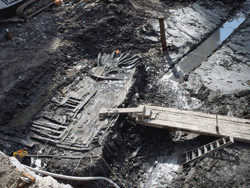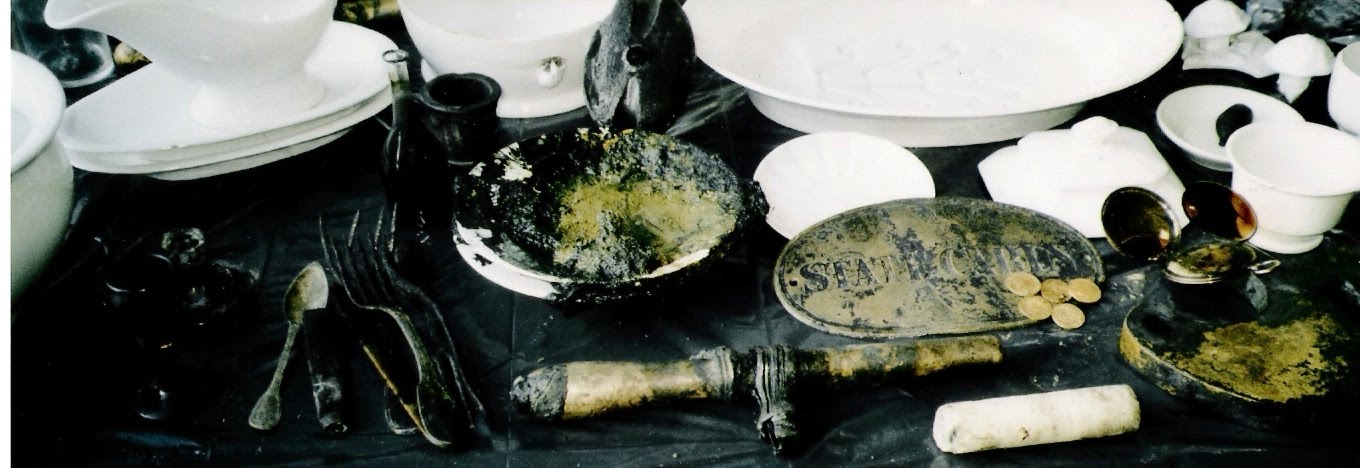By Jarrett A. Lobell
The ship lay buried in mud for two centuries as New York City grew up around it. The last time it sailed along the East Coast and pulled into the harbor on the west side of the island, Manhattan's population was probably less than 20,000. Just five blocks from the ship's final resting place, George Washington had recently been inaugurated at Federal Hall on Wall Street as president of the newly formed United States, of which New York was the first capital.
After its last voyage, its owners pulled the ship up onto the shore in order to perform routine maintenance. But it's believed that when they removed the outer sheathing and saw that the lower timbers were too far gone to repair, they saved what was still useable and left the rest behind.
At the end of the eighteenth century, Lower Manhattan—the area around the original 1624 Dutch settlement—was too cramped and the harbor too small for the volume of trade that was coming into New York. In the late 1790s, the city began deliberate efforts to extend the shoreline farther out into the Hudson River, thereby expanding the size and usefulness of the harbor. By the 1830s, the area had been completely filled and the new shoreline lay 200 yards west of its original location at modern Greenwich Street.Over the decades, the earth brought in for the shoreline extension—and the trash discarded there—completely covered up the ship. The thick, clay-rich soil sealed the vessel in the fill, creating an anaerobic (oxygen-free) environment that saved the ship from decay due to bacteria that grow in aerobic (oxygen-rich) environments.
On the morning of July 13, 2010, during construction for the Vehicle Security Center at the new World Trade Center (WTC), Molly McDonald, one of the archaeologists from AKRF, the environmental and planning consultants monitoring the site for the Port Authority of New York and New Jersey, stopped the backhoes. "It was 6:00 a.m. and I had just arrived on the site to oversee the demolition of a nineteenth-century wooden dock.A few minutes later, I saw two small curved timbers sticking out of the mud and said to Michael Pappalardo, the principal investigator at the site, 'It has to be a ship.'" Immediately Pappalardo and McDonald began excavating the area by hand. They were quickly joined by several other AKRF archaeologists, including Assistant Project Manager Elizabeth Meade. Soon the team had exposed the vessel's frame and some of its planking, and by the end of the week, they had uncovered the stern. It is possible that the bow of the ship remains buried at the site.
Knowing that they would have to move fast to prevent the ship from falling apart from exposure to oxygen and sun, Diane Dallal, Director of Archaeology at AKRF, consulted Doug Mackey of the New York State Preservation Office, Norman Brouwer, former maritime historian at the South Street Seaport Museum, and conservator Gary McGowan. In consultation with the Lower Manhattan Development Corporation, the agency leading the preservation effort, all came to the conclusion that it would be impossible to preserve the ship in situ, where it would almost certainly be damaged by continued construction, and that it would be best to remove it piece by piece.
First AKRF considered digging around and under the stern and then lifting the ship in one piece, as was done two years ago with the ancient Roman boats found in the Naples harbor ("Naples Underground," May/June 2008), but concluded that the remains were too fragile.
Dallal next contacted Warren Riess of the University of Maine, an expert on eighteenth-century ships."Even though I have sworn off fieldwork to see to other projects, when I heard about the discovery, I had to come and see for myself," says Riess. "As soon I looked at it, I knew it had been a good-sized vessel, about 60 to 70 feet long and 18 feet wide, dating from the late eighteenth or very early nineteenth century."It was clear to Riess that this was a rare find—he estimates there are fewer than five other ships of this type and period to have been found, and none were put together exactly like this one. Everyone agreed that the best strategy was to dismantle the ship to move it to safety.
 Lower Manhattan Development Corporation/AKRF
Lower Manhattan Development Corporation/AKRF
Posted via email from
.jpg)
No comments:
Post a Comment